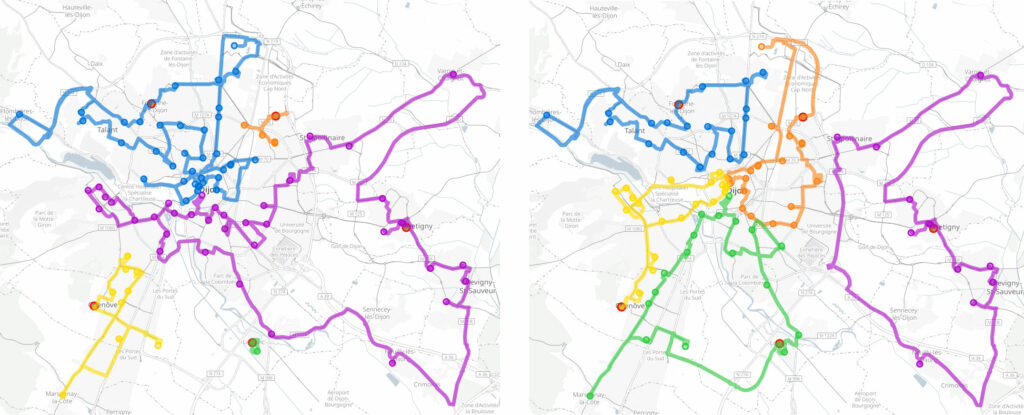We are constantly working to improve our API and provide our clients with the best possible vehicle routes for their business. Zero in on our most recent reworking that draws on a new version of VROOM, the open-source software that we have developed for optimizing fleet operations.

ENHANCED MODELS FOR PROBLEM SOLVING
Workload Management
Achieving efficient cost-reducing routes is sometimes not enough from a practical perspective, as shown above (left). To adhere to a plan of operation while maintaining a balanced distribution of work involves avoiding discrepancies in workloads (right).
Until now, we have limited loads by using a default figure for maximum capacity. It is now possible to enter the maximum number of jobs each vehicle can handle. Not only does this new approach work for all kinds of tasks, but it also cuts calculation times in half while continuing to respect the usual time constraints in the field.
Modeling of Service Times
Frequently, several jobs are carried out at the same location, as when deliveries are made to several residents in an apartment building or when pick-ups for different clients are made at a store. In this instance, some of the time spent at this location is the same for several jobs and cannot be calculated in each instance as service time. With this in mind, we have introduced the notion of a setup period to model the time it takes to park and arrive at the site. The service times for the individual jobs carried out remain cumulative, as before, but the setup period for that one location is counted only once.
Making Use of Existing Schedules
It doesn’t always make sense to start from scratch when problem solving, such as making marginal changes to an existing schedule or simply testing the feasibility of adding jobs. This is especially the case for appointments made online that have to be confirmed (or denied) quickly. For problems of this kind, it is now possible for clients to provide an existing schedule for optimization as the initial step in the high-speed solution-finding process.
Improving Problem Solving
Conceiving and improving approaches for optimization lie at the heart of our expertise. In addition to the functionalities we have added, we have also brought into play a new local search neighborhood, a version of Thibaut Vidal’s SWAP* operator that appeared in a recent article and that we have adapted for our purposes to manage an even greater number of constraints, time constraints in particular. For some reference benchmarks, the average gap to optimal solutions has been reduced from an already low +1.73% to +1.32%, which, given our impressive calculation times, is quite significant.
Contact us if you would like to try out these additions and improvements to our API for route optimization.
